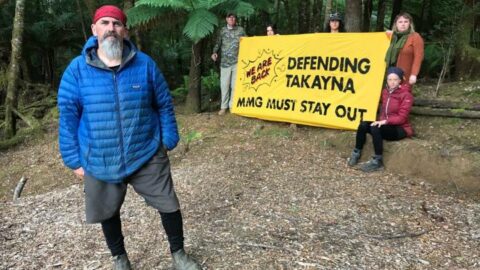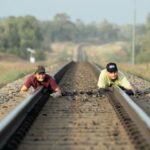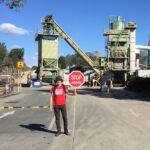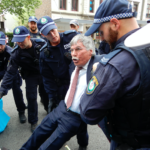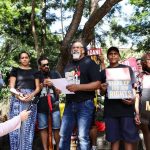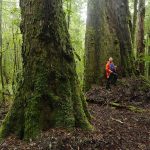Protecting the Pristine Takayna/Tarkine: An Interview With Bob Brown Foundation’s Scott Jordan
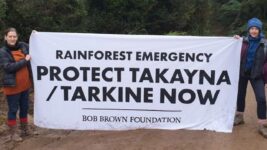
Right now, Chinese mining company MMG is attempting to construct a huge heavy metal waste dump in the middle of the takayna/Tarkine Rainforest: the nation’s largest surviving temperate forest of its kind.
This means acid-producing tailings from the nearby Rosebery mine will be poured into a dam that requires the clearing of 285-hectares of the pristine ancient rainforest that’s home to dozens of endangered species.
The company is taking this option, which involves extensive environmental destruction, not because its necessitated, but as it’s the cheapest option.
With the Morrison government, including key enemy of nature federal environment minister Sussan Ley, agreeing that short-term savings outweigh the future of the planet.
The Bob Brown Foundation has been running a determined campaign against the destruction of the takayna/Tarkine. And it underscores that the preservation of the heritage site in no way threatens the running of the mine itself, and the economic benefits and employment it has long provided.
“Irreversible damage” greenlighted
The Foundation is taking the environment minister to the Federal Court to challenge her approval of the toxic dump on First Nations land in July.
On Monday, BBF sought an injunction to prevent MMG going ahead with preliminary works for the tailings dam. However, this was denied.
While disappointed by the decision, BBF isn’t too phased about it because it’s had volunteers on the ground for a number of years preventing the mining company from going ahead with its operations simply by sticking their bodies in the way of its machinery.
Following the court decision on Tuesday, citizens were back at the site ensuring any clearing would not be going ahead. And Tasmanian police officers turned up to serve the group with a 14 day move-on order, which is unlikely to have any significant impact on the blockade itself.
Two arrests were made, as 73-year-old Kevin Vaughan and 69-year-old Andrew Browne refused to follow police orders to move on.
While the Foundation stated in a release that “it appears Tasmania is being governed for the native forest logging corporations and mining company MMG”.
“Not prepared to allow that”
The Bob Brown Foundation is quite confident that the tailings dam won’t be going ahead, due to the content of the submissions it’s putting to the court, and also the fact that it’s going to have bodies on the ground at the site everyday preventing MMG from proceeding.
Indeed, after the cops had hauled the protesters away on Tuesday, 35-year-old local nurse Jade Elford returned to the site that evening to block road access. And like the hundreds more before her, there are hundreds more to come in the mission to save the takayna/Tarkine Rainforest.
Sydney Criminal Lawyers spoke to Bob Brown Foundation Tarkine campaigner Scott Jordan about the easy and obvious alternative that MMG has open to it, which doesn’t require the destruction of the ancient forest, and how he and others like him won’t be leaving until it takes that option.
Currently, MMG is planning to construct a tailings dam in the takayna/Tarkine Rainforest that would be used to store heavy metal waste produced by the Rosebery zinc, copper and lead mine, which is situated about a kilometre from the proposed site.
Scott, can you speak on the significance of the takayna?
Takayna is an outstanding natural area. It’s an area that has been verified as having both natural heritage and world heritage values, and yet, it remains unprotected because of the failures of subsequent governments.
This area is home to Australia’s largest remaining temperate rainforest. It’s home to over 50 rare and endangered species.
In the area that they plan to put this tailings dam, we know that it’s home to the Tasmanian Devil. It’s home to the Spotted Quoll. We know it’s home to the Wedge-Tailed Eagle.
And most recently, we’ve been able to document that it’s a significant home for the Tasmanian Masked Owl.
The Bob Brown Foundation is challenging the decision of federal environment minister Sussan Ley to allow the tailings dam to go ahead. A court decision on an injunction application against MMG was delivered yesterday.
So, how’d the proceedings go?
We had a decision on the injunction yesterday, and it didn’t go our way. The court was satisfied that some undertakings from the company were sufficient, and it wouldn’t require an injunction.
However, we’re a bit baffled by that decision. The undertakings given by MMG allow them to operate exploration drill machinery within 15 metres from the Masked Owl nest. Now, this is equipment that runs at a volume equivalent to a jet aircraft.
So, the idea that would be happening numerous times just 15 metres away from the Masked Owl nest and it won’t impact on that species has just baffled us.
So, we’re still onsite. And police are onsite at the moment, removing a couple of protesters. One who refuses to leave a tree and another who refuses to leave the road and is locked onto the position.
We will continue to protect this site every day.
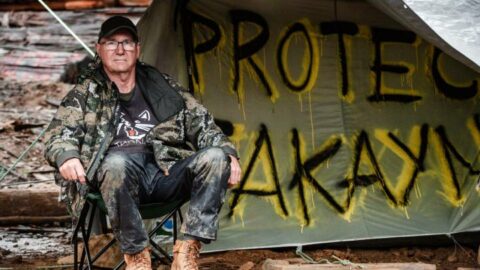
So, does yesterday’s decision affect the substantial Federal Court proceedings?
The decision yesterday was just on the injunction. So, the case against the federal approvals will be heard in July. However, we sought an injunction to prevent the company from doing any work prior to the hearing.
We were unsuccessful in getting that injunction and so, again it falls on our brave volunteers, who put their bodies on the line every day out at the forest and in the way of the mining company to stop the machinery from coming in.
The Foundation is also challenging the decision of Tasmanian resources minister Guy Barnett to grant MMG a lease to Helilog Road, which provides access to the tailings dam site.
There are some controversial provisions within the conditions of the lease. And this challenge is set to take place in the Supreme Court.
What will your main argument be? And why do some of the stipulations within the lease raise eyebrows?
There are a couple of issues with the lease. Firstly, the Mineral Resources Development Act in Tasmania does allow you to get a mine lease in the event that you require an inlet to access a mine.
However, this area has an existing public road that runs right through it. And in fact, this lease would prevent us from accessing that public road and one hundred metres either side of it.
In documents received under rights of information, it’s clear that the company sought this lease only to prevent protesters from accessing that road area.
So, they’re effectively denying us access within six and a half kilometres within the start of the pre-existing roadway.
But the Mineral Resources Development Act doesn’t allow a lease to prevent protesters. It allows for a bona fide easement. In this case an easement isn’t required because there are already existing public access roads.
In fact, they’ve got a road use agreement with the land manager to allow them to use that road for heavy machinery.
So, we don’t see this lease as anything but an opportunity to shut down protest, and our argument is, the act doesn’t allow for that.
You’ve already touched on this, but the Bob Brown Foundation and supporters have been running a campaign to block access to the dam site for quite some time now. How is that action going? And how effective has it been?
The blockade began in December 2020, when we moved in to protect that spot from the logging and the mining of it. In May last year, the police rolled in large numbers and removed that protest camp.
So, for the next sixty days we based out of a premises at nearby Tullah, and we rolled teams in every day to shut down the operations to prevent the company from bringing in the machines to prevent the destruction of that rainforest.
At the end of that period, our lawyers were able to show that MMG didn’t in fact have the necessary permits to be doing that work so, as a result of that, they were forced to withdraw their machines.
So, we got a bit of a reprieve between late July and December. Then we rolled back in due to news that the minister was about to give those approvals.
So, from December 2020, we’ve occupied that site. And we intend to contain MMG’s destruction of that area and prevent them from accessing it.
In January this year, we rolled back in to reoccupy that space, and we are there for the duration.
People are being removed by police as we speak, and I wouldn’t have to be too much of a prophet to say that we will have people back at that site overnight, and again the next day and the next day.
In fact, around camp we just say, “We’ll be there one more day and then…”
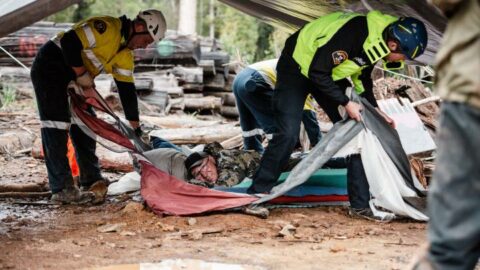
There have been issues raised about the employment and economic impact the denial of the tailings dam proposal could have for the continuing of the Rosebery mine, which is a very old operation. In your understanding, are there viable alternatives?
There are. In fact, at no point in this campaign have we sought to close the Rosebery mine. As you said, it’s a pre-existing mine that has been operating for over 80 years. So, we’re not seeking to prevent the mine, and we’re not seeking to close it.
What we are saying is that in the 21st century, dumping toxic acid producing heavy metal waste into a world heritage verified area of significant rainforest is just something that shouldn’t be happening.
In comparable jurisdictions around the world, it wouldn’t be allowed to happen.
Best practice around the globe is to move to what’s called a paste fill plant, where they take the tailings that have previously been dumped into these dams and mix them into a concrete paste.
That is then injected back in to fill the void in the mine, which not only disposes of the waste in a much more environmentally friendly manner and prevents the acid producing tailings flowing back into the environment, but it actually stabilises the workings of the mine.
In fact, the company already pumps concrete into those voids. The difference being it would cost them money to put their tailings into that concrete, and they don’t want to spend the money.
So, they’re looking for the cheap and easy way, and our government is prepared to allow that.
We’re not prepared to allow that. So, we will be there until the company chooses to do the right thing.
Recently, the 2021 Sharma decision was overturned. It was a declaration made by the Federal Court last year that stipulated the federal environment minister had a duty of care to the health of Australian children when making decisions regarding fossil fuel projects.
Do you think if it stood, the duty of care may have had implications for your case against the tailings dam? And what do you think about its overturning in general?
Conservationists around the country were disappointed by the overturning of that decision. The idea that the minister doesn’t have a duty of care to either the environment or the future of the planet is baffling.
They should perhaps stop calling them the minister for the environment because they have no duty of care to the environment.
But we can’t spend too much time wondering what might have happened if that decision did stand.
We’ve got a lot going on in the courts at the moment with cases we’re confident we have a winning chance in, and we have a blockade on the ground to make sure that if those court decisions come back in our favour in months to come, the damage won’t have already been done.
So, we have that two-pronged strategy. One is just being in the way. Two is seeking remedy from the court.
And lastly, Scott, with a federal election pending, do you consider a change of government may affect the final decision on the tailings dam?
I don’t think so. I’ve not been given any evidence that suggests that would be the case.
Our government, both Labor and Liberal, have failed the environment over a long period. And they’ve both generally been kowtowing to mining companies.
In this case, it’s a mining company owned by the Chinese state government.
So, it’s really going to come down to citizens being prepared to back actions in the court, to back actions in the forest and to be banging on the doors of the politicians and demanding that they take action.
Until the people speak with their feet, the politicians will be reluctant to act.
